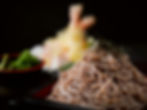Soba: The Healthy Cousin of Ramen Noodles
- Sho Chirathivat
- May 30
- 4 min read
Updated: Sep 24
After days of indulging in heavy bowls of ramen, endless confections, and mouth watering street food on your trip to Japan, you might find yourself craving something lighter yet still satisfying. Enter: soba, the healthier cousin of ramen noodles!

Made primarily from buckwheat flour, soba is hearty, nourishing, and a perfect example of how Japanese cuisine masterfully blends health and taste. If you're searching for a meal that not only hits the spot but also is good for you, soba is the answer.
The Rich History of Soba
Soba is one of Japan's oldest foods, with roots stretching back thousands of years. The form of soba we recognize today emerged during the Edo period (1603–1868). The most prestigious soba restaurants proudly carry the term "Edo-soba," symbolizing centuries of technique passed down through generations.

Not every restaurant using this term has that deep lineage—clever marketing exists everywhere—but true Edo-soba masters carry a level of prestige. These artisans have been perfecting their craft for centuries, creating noodles with exceptional texture and flavor that simply can't be replicated by newcomers. Don’t mess with these masters, they’ve been honing their art forever!
While soba is beloved throughout Japan, it holds a special place in the eastern Kanto region (including Tokyo), whereas the western Kansai region (including Osaka and Kyoto) traditionally favors udon.
What Makes Soba, Soba?
If you've never tried buckwheat noodles before, soba will introduce you to an entirely new flavor experience. Buckwheat gives soba a distinctly earthy, roasted, and slightly nutty taste that is much richer than the soft, neutral flavors of wheat-based noodles.

To better understand soba's place in Japanese cuisine, it helps to compare it with Japan's other famous noodles:
Soba
Made primarily from buckwheat flour, featuring an earthy flavor and typically served with a light, soy-based broth or dipping sauce.

Udon
Thick, chewy noodles made from wheat flour. Traditional udon broths are light, but modern versions can be much richer, think fusion dishes like curry or even carbonara udon.

Ramen
Wheat flour noodles made with alkaline water (kansui), giving them a springy, al dente, texture. Ramen is characterized by hearty, often meat-based broths seasoned with soy sauce, salt, miso, or flavored oils for bold, intense flavors.

In essence: soba is subtle and refreshing, udon is soft and versatile, and ramen is rich and punchy.
Hot or Cold: The Versatility of Soba Noodles

One of soba's greatest qualities is its versatility. It can be enjoyed hot or cold, depending on your mood, the season, or your personal preference.
Cold Soba Varieties
Cold soba lets the natural flavors and firm texture (koshi) of the noodles shine. Two popular preparations include:
Mori Soba
Served with a sprinkling of charcoal-glazed nori seaweed, enhancing both appearance and aroma.
Zaru Soba
The purest form, served with just the boiled noodles and a simple chilled dipping sauce (tsuyu or tare).

Soba enthusiasts often debate passionately over which preparation is superior, with purists insisting that cold zaru soba is the only way to truly appreciate the noodle's authenticity. But, I’ll let you decide which preparation you like the most.
Warm Soba Varieties
On the flip side, warm soba provides deep comfort during colder months. The warm broth clings to the noodles, creating a cozy, satisfying meal. Popular warm soba varieties include:
Tempura Soba
Topped with crispy tempura, creating a delightful textural contrast as the batter gradually soaks up the flavorful broth.

Kake Soba
A simple preparation where the noodles are served in a hot broth, a simple preparation perfect for cold winter evenings.

Soba in Every Setting
Soba fits seamlessly into every corner of Japanese life, from quick meals to elegant dining experiences. Here are some places you can find soba in Japan:

Eki-Soba (Station Soba)
Forget McDonalds, Eki-soba is Japan’s ultimate fast food. Translated to train station soba, restaurants serving piping hot soba in busy train stations and even on train platforms can be found throughout Japan for a super quick bite served before catching the train.
Tachigui Soba (Standing Soba)
Standing soba restaurants are exactly as they sound—no-frills establishments where you can eat soba while standing. You’ll often find ultra busy office workers ducking into Tachigui Soba shops for a quick lunch break between meetings.

High-End Soba
Now it’s time to sit back and relax. High-end soba restaurants offer full-course meals where seasonal appetizers are paired with these buckwheat noodles, often blurring the lines between traditional Japanese restaurants and specialized soba establishments.

Toshikoshi Soba
Literally "year-crossing noodles," this beloved tradition involves eating soba on New Year's Eve to symbolize longevity, with the long noodles representing a long, healthy life ahead.

Soba: Two Birds With One Stone!
What truly makes soba special is how it brings together exceptional flavor, nutrition, and simplicity.
Since soba is made primarily from buckwheat, it's generally more nutritious than other Japanese noodles. This makes soba an excellent option for health-conscious diners, vegetarians, and even those with gluten sensitivities (when choosing 100% buckwheat varieties).

Next time you're in Tokyo, step away from the ramen queue and seek out a quality soba restaurant. Whether you choose the refreshing simplicity of cold zaru soba on a hot summer day or the comforting warmth of hot tempura soba in the winter months, you'll discover that healthy, delicious food doesn't have to be complicated or expensive.

With careful preparation and traditional technique, even simple ingredients like buckwheat can be transformed into something extraordinary. Soba proves that you can indeed have the best of both worlds with a meal that's both healthy and delicious.




